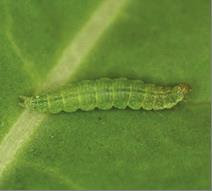The Wheat Stem Maggot, Meromyza americana (Diptera) is a minor pest that causes eye-catching damage in wheat, rye, barley, oat, millet, timothy, brome, crested wheatgrass and bluegrass. This is a timely insect of the week, because the larval damage (dead white heads in an otherwise green field) started to appear in the last few weeks and is now highly visible in many fields.
Your eyes are naturally drawn to these white heads and can cause you to overestimate the actual amount of damage to your fields. However, the damage is usually limited to 1-5% of the crop. To identify if the wheat stem maggot is the culprit, gently pull on the white head to see if it easily separates from the flag leaf sheath and shows evidence of feeding damage at the base of the culm.
By the time you see damage, the greenish-white larva has exited and is off to begin a second generation that will overwinter in volunteer cereals. There are no registered chemicals or resistant varieties so your best management practices are rotate to non-cereals/non-grassses, destroy infested stubble, and control volunteer hosts and grassy weeds. Delayed seeding, where/when possible may also limit damage.
 |
| Wheat stem maggot damage (Tyler Wist - AAFC) |


































